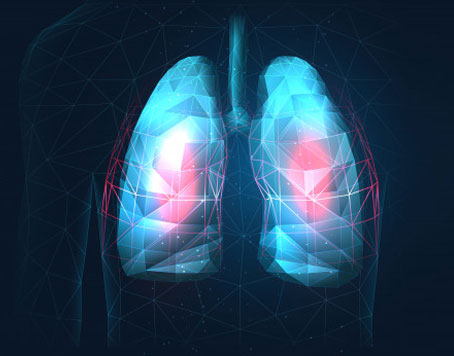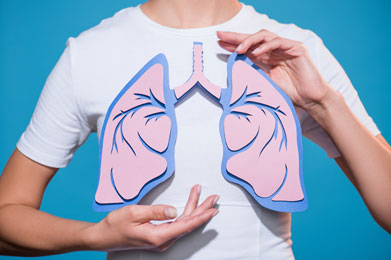Lung Disease
The Lungs are the essential respiratory organ in air breathing living beings and lungs are a pair of spongy, air-filled organs, located near the backbone on either side of the heart. Trachea (windpipe) conducts inhaled air into the lungs through its tubular branches called bronchi. The bronchi then divide into smaller and smaller (bronchioles), finally becoming microscope. The principal function is to transport oxygen from the atmosphere into the bloodstream , and to release CO2 from the bloodstream into the atmosphere.
There is one another type of cells alveoli in lungs where all bronchioles end in cluster. In alveoli, oxygen from air is absorbed into the blood and CO2 which is waste product of metabolism, travels from the blood to the alveoli, where it can be exhaled. Between the alveoli is a thin layer of cells called interstitium, which contains blood vessels and cells that help support the alveoli.

The lungs are covered by a thin tissue layer called pleura, a thin layer of fluid acts as a lubricant allowing the lungs to slip smoothly as they expand and contract with each breath.
Lung disease is leading causes of morbidity and mortality worldwide. Pulmonary diseases characterized by loss of lung elasticity, small airway tethers, and luminal obstruction with inflammatory mucoid secretions and excessive matrix deposition and destruction of the normal lung architecture.
Regeneration of pulmonary tissue by stem cells transplantation from endogenous, exogenous, is a promising novel therapy. The use of adult stem cells to help with lung regeneration and repair could be a newer technology in clinical and regenerative medicine. In fact, different studies have shown that stem cells contribute to repair and remodeling of lung in animal and human models of progressive pulmonary diseases.
TYPES OF LUNG DISEASE TREATED BY STEM CELL THERAPY:-
1. Idiopathic Pulmonary Fibrosis (IPF):- IPF is an interstitial inflammatory disease with unknown etiology characterized by scarring and fibrosis of the lungs that ultimately result in terminal pulmonary insufficiency. Mesenchymal stem cell transplantation in IPF disease provides

2. Chronic obstructive pulmonary disease (COPD):- COPD is a lung disease which includes both chronic bronchitis and emphysema. COPD is one of the leading causes of death and disability in all over the world and which results predominantly from cigarette smoking.
There are two main forms of COPD
"Chronic bronchitis" is a chronic inflammation of the bronchi (medium-size airways) in the lungs which involves a long-term cough with mucus
"Emphysema" which is called an obstructive lung disease because the destruction of lung tissue around smaller sacs, called alveoli, makes these air sacs unable to hold their functional shape upon exhalation. Emphysema is most often caused by tobacco smoking and long-term exposure to air pollution involves destruction of the lungs over time
Mesenchymal stem cell transplantation has many advantages in COPD patients follow as:-
